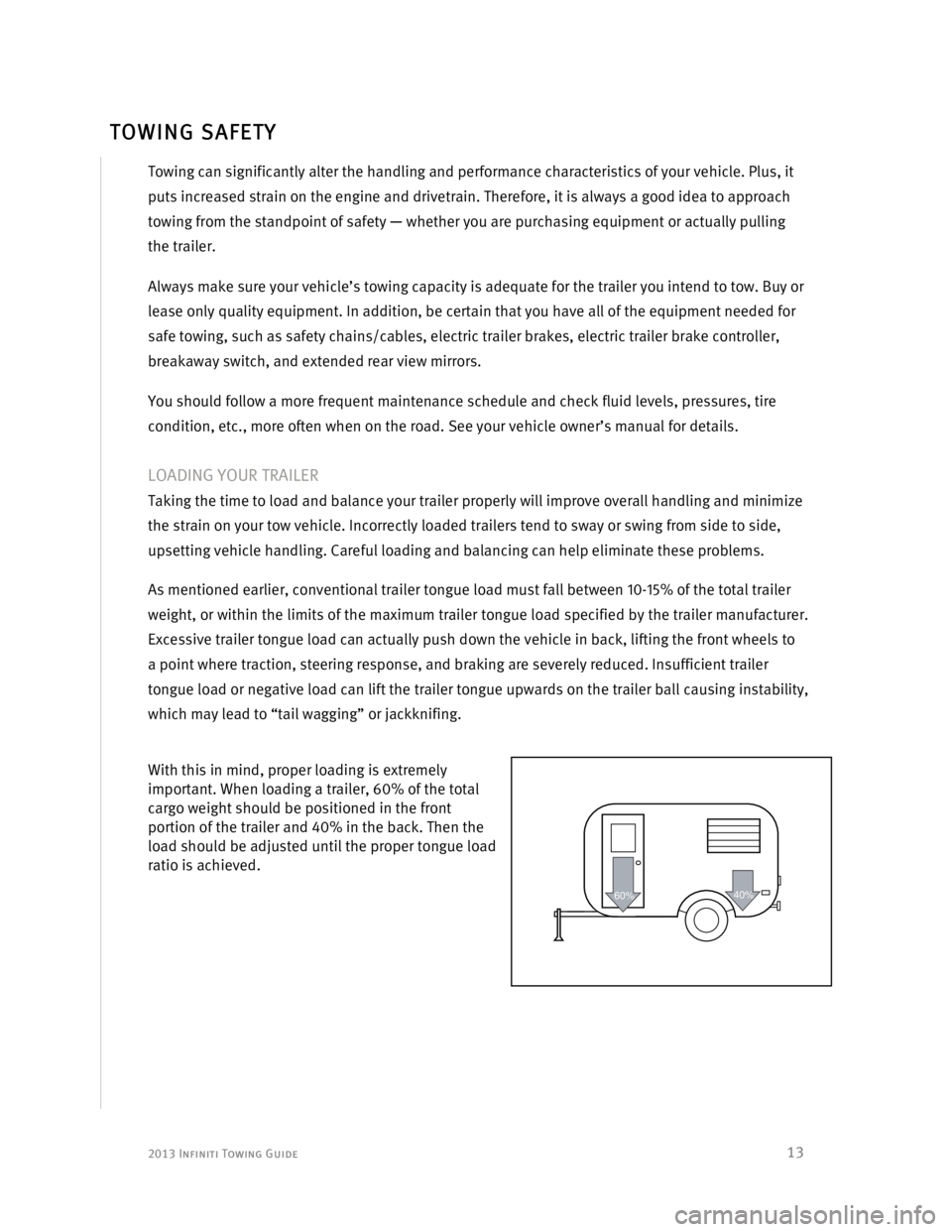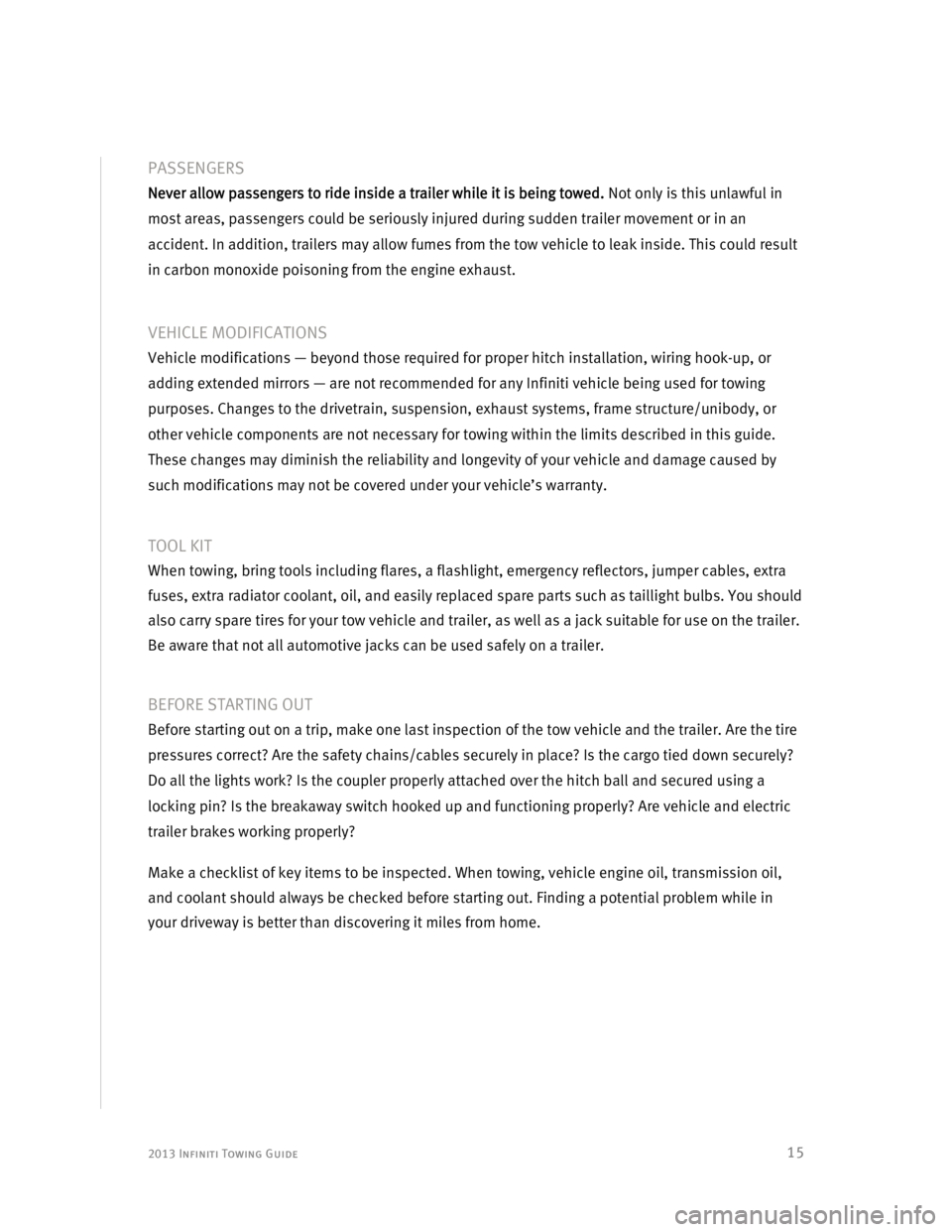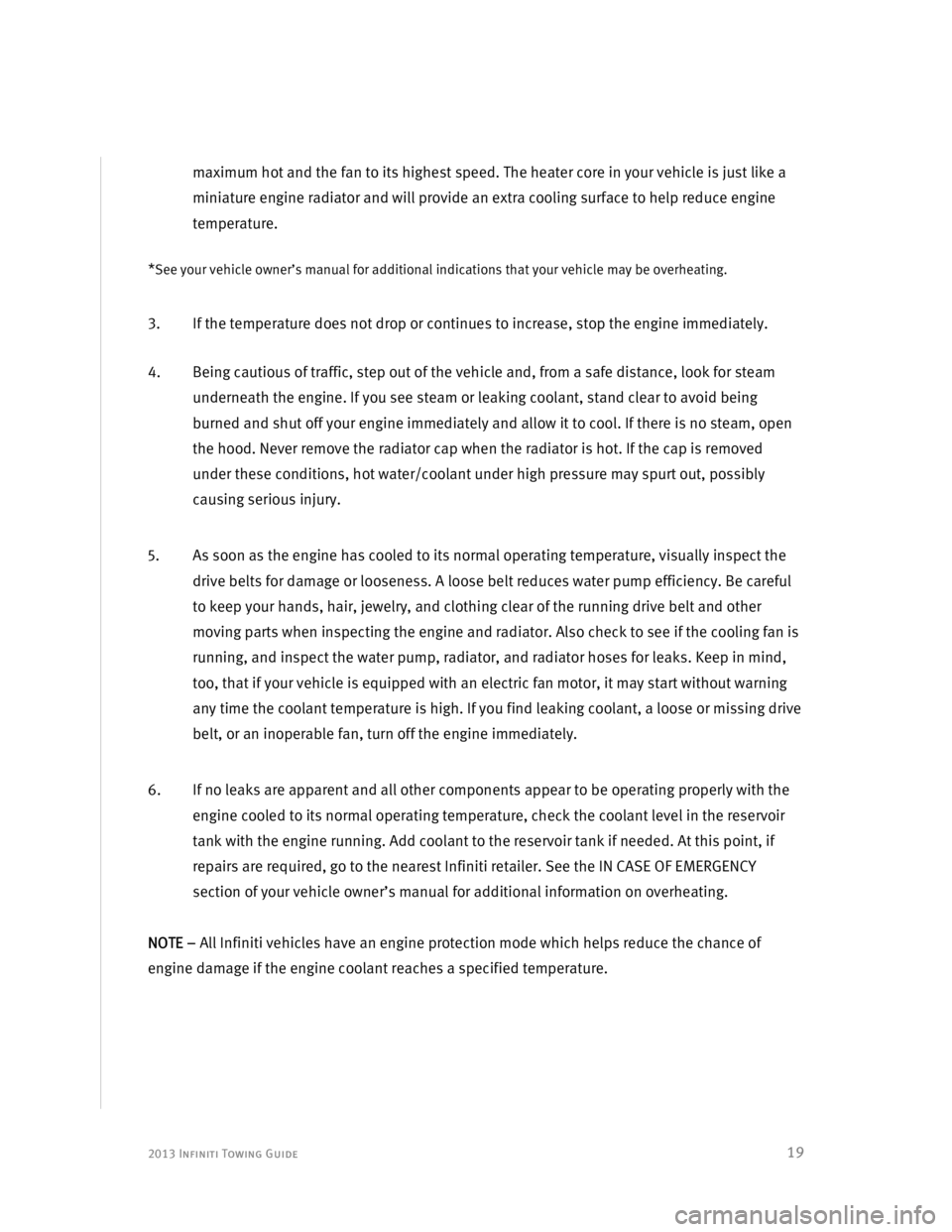check engine INFINITI JX 2013 Towing Guide
[x] Cancel search | Manufacturer: INFINITI, Model Year: 2013, Model line: JX, Model: INFINITI JX 2013Pages: 25, PDF Size: 0.42 MB
Page 14 of 25

2013 Infiniti Towing Guide
13
Towing can significantly alter the handling and performance characteristics of your vehicle. Plus, it
puts increased strain on the engine and drivetrain. Therefore, it is always a good idea to approach
towing from the standpoint of safety — whether you are purchasing equipment or actually pulling
the trailer.
Always make sure your vehicle’s towing capacity is adequate for the trailer you intend to tow. Buy or
lease only quality equipment. In addition, be certain that you have all of the equipment needed for
safe towing, such as safety chains/cables, electric trailer brakes, electric trailer brake controller,
breakaway switch, and extended rear view mirrors.
You should follow a more frequent maintenance schedule and check fluid levels, pressures, tire
condition, etc., more often when on the road. See your vehicle owner’s manual for details.
LOADING YOUR TRAILER
Taking the time to load and balance your trailer properly will improve overall handling and minimize
the strain on your tow vehicle. Incorrectly loaded trailers tend to sway or swing from side to side,
upsetting vehicle handling. Careful loading and balancing can help eliminate these problems.
As mentioned earlier, conventional trailer tongue load must fall between 10-15% of the total trailer
weight, or within the limits of the maximum trailer tongue load specified by the trailer manufacturer.
Excessive trailer tongue load can actually push down the vehicle in back, lifting the front wheels to
a point where traction, steering response, and braking are severely reduced. Insufficient trailer
tongue load or negative load can lift the trailer tongue upwards on the trailer ball causing instability,
which may lead to “tail wagging” or jackknifing.
With this in mind, proper loading is extremely
important. When loading a trailer, 60% of the total
cargo weight should be positioned in the front
portion of the trailer and 40% in the back. Then the
load should be adjusted until the proper tongue load
ratio is achieved.
60%40%
TOWING SAFETY
Page 16 of 25

2013 Infiniti Towing Guide
15
PASSENGERS
Never allow passengers to ride inside a trailer while it is being towed. Not only is this unlawful in
most areas, passengers could be seriously injured during sudden trailer movement or in an
accident. In addition, trailers may allow fumes from the tow vehicle to leak inside. This could result
in carbon monoxide poisoning from the engine exhaust.
VEHICLE MODIFICATIONS
Vehicle modifications — beyond those required for proper hitch installation, wiring hook-up, or
adding extended mirrors — are not recommended for any Infiniti vehicle being used for towing
purposes. Changes to the drivetrain, suspension, exhaust systems, frame structure/unibody, or
other vehicle components are not necessary for towing within the limits described in this guide.
These changes may diminish the reliability and longevity of your vehicle and damage caused by
such modifications may not be covered under your vehicle’s warranty.
TOOL KIT
When towing, bring tools including flares, a flashlight, emergency reflectors, jumper cables, extra
fuses, extra radiator coolant, oil, and easily replaced spare parts such as taillight bulbs. You should
also carry spare tires for your tow vehicle and trailer, as well as a jack suitable for use on the trailer.
Be aware that not all automotive jacks can be used safely on a trailer.
BEFORE STARTING OUT
Before starting out on a trip, make one last inspection of the tow vehicle and the trailer. Are the tire
pressures correct? Are the safety chains/cables securely in place? Is the cargo tied down securely?
Do all the lights work? Is the coupler properly attached over the hitch ball and secured using a
locking pin? Is the breakaway switch hooked up and functioning properly? Are vehicle and electric
trailer brakes working properly?
Make a checklist of key items to be inspected. When towing, vehicle engine oil, transmission oil,
and coolant should always be checked before starting out. Finding a potential problem while in
your driveway is better than discovering it miles from home.
Page 20 of 25

2013 Infiniti Towing Guide
19
maximum hot and the fan to its highest speed. The heater core in your vehicle is just like a
miniature engine radiator and will provide an extra cooling surface to help reduce engine
temperature.
*
See your vehicle owner’s manual for additional indications that your vehicle may be overheating.
3. If the temperature does not drop or continues to increase, stop the engine immediately.
4. Being cautious of traffic, step out of the vehicle and, from a safe distance, look for steam
underneath the engine. If you see steam or leaking coolant, stand clear to avoid being
burned and shut off your engine immediately and allow it to cool. If there is no steam, open
the hood. Never remove the radiator cap when the radiator is hot. If the cap is removed
under these conditions, hot water/coolant under high pressure may spurt out, possibly
causing serious injury.
5. As soon as the engine has cooled to its normal operating temperature, visually inspect the
drive belts for damage or looseness. A loose belt reduces water pump efficiency. Be careful
to keep your hands, hair, jewelry, and clothing clear of the running drive belt and other
moving parts when inspecting the engine and radiator. Also check to see if the cooling fan is
running, and inspect the water pump, radiator, and radiator hoses for leaks. Keep in mind,
too, that if your vehicle is equipped with an electric fan motor, it may start without warning
any time the coolant temperature is high. If you find leaking coolant, a loose or missing drive
belt, or an inoperable fan, turn off the engine immediately.
6. If no leaks are apparent and all other components appear to be operating properly with the
engine cooled to its normal operating temperature, check the coolant level in the reservoir
tank with the engine running. Add coolant to the reservoir tank if needed. At this point, if
repairs are required, go to the nearest Infiniti retailer. See the IN CASE OF EMERGENCY
section of your vehicle owner’s manual for additional information on overheating.
NOTE – All Infiniti vehicles have an engine protection mode which helps reduce the chance of
engine damage if the engine coolant reaches a specified temperature.